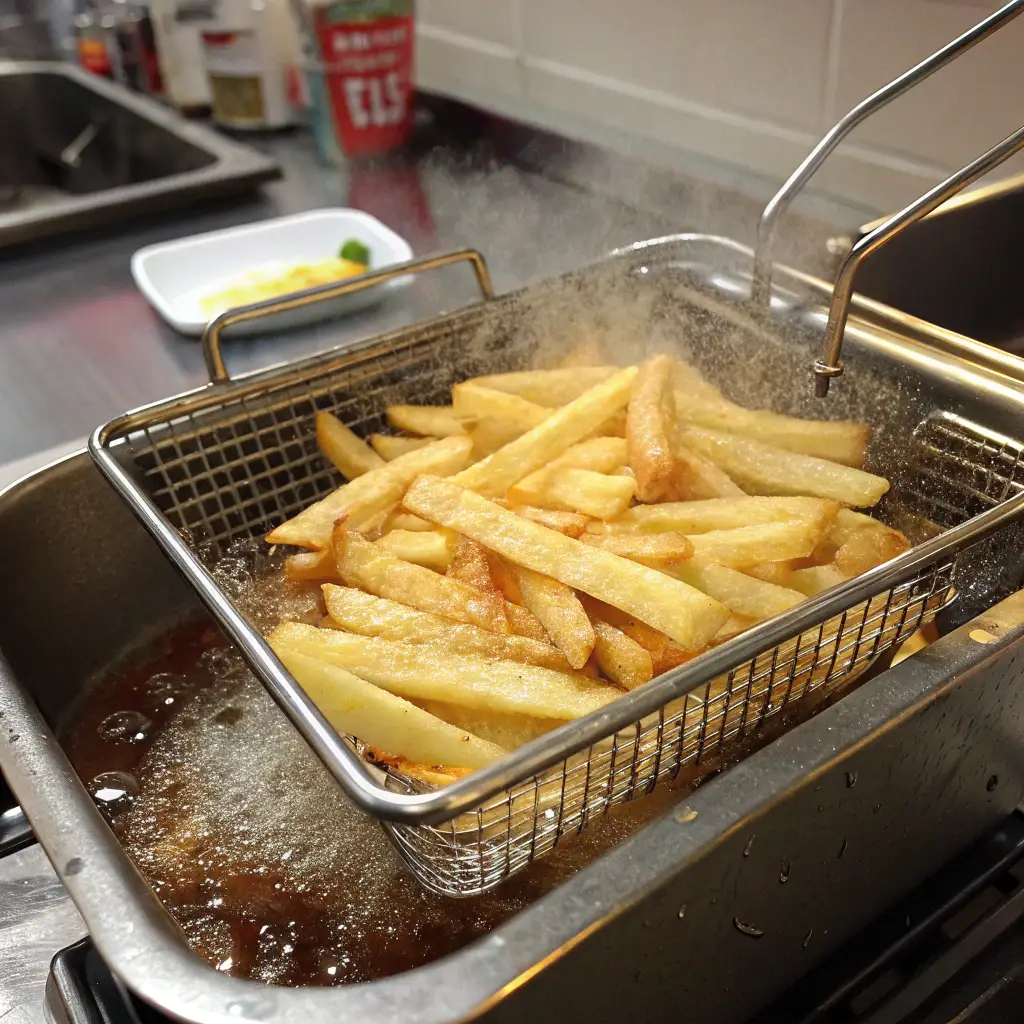Picture this: You’re biting into a golden, crispy, fresh-out-the-fryer batch of Steak ‘n Shake’s famous shoestring fries. But wait—something’s different. They taste… richer. More flavorful. Just like the fries from the good ol’ days before fast-food chains went all-in on vegetable oils.
That’s because Steak ‘n Shake is making a big move—bringing back 100% beef tallow for frying! Yep, they’re ditching the processed oils and going back to a tried-and-true method that made fast food fries legendary. But why the change? Is it healthier? Will it taste better? And, most importantly—what do customers think?
This article covers everything from the history of beef tallow in fast food to health impacts, consumer reactions, and what this shift means for the industry. So, grab a snack (maybe some fries) and let’s dive in!
Table of Contents
the Announcement and Its Significance
Steak ‘n Shake’s Big Shift: Back to 100% Beef Tallow

In a surprising yet exciting twist, Steak ‘n Shake announced in early 2025 that it’s switching back to 100% beef tallow for frying its famous fries. This decision brings a major change to the brand’s cooking process, which had relied on vegetable oils for decades.
So, why the shift? According to the company, it’s all about bringing back that classic, authentic taste customers loved in the past. Fries cooked in beef tallow tend to be crispier on the outside, fluffier on the inside, and packed with a deep, savory flavor that vegetable oils just can’t match.
The rollout of beef tallow frying will happen in phases, with full implementation expected by the end of February 2025. Customers have already started to notice—and react. But before we get into that, let’s take a quick trip down memory lane.
The Glory Days of Beef Tallow in Fast Food
Back in the day—think pre-1990s—many fast-food giants, including McDonald’s, used beef tallow for frying. This was the golden era of crispy, flavorful fries, and if you ask anyone who remembers, they’ll tell you: those fries just hit different!
However, in the 1990s, a wave of health concerns over saturated fats led to a massive industry shift. Fast-food chains abandoned animal fats in favor of vegetable oils, claiming they were a healthier alternative. McDonald’s famously switched from beef tallow to a blend of vegetable oils in 1990, bowing to pressure from health advocates.
But here’s the kicker: many experts now say that swap may not have been as healthy as once believed. And consumers? Well, they never really stopped craving the rich, crispy goodness of tallow-fried fries.
Why Steak ‘n Shake’s Decision Matters
Steak ‘n Shake isn’t just bringing back an old-school frying method—it’s making a statement. This move aligns with a larger trend of fast-food chains revisiting traditional cooking methods to meet customer demand for better taste and fewer processed ingredients.
With major chains like Popeyes and Smashburger also embracing beef tallow, it’s clear that the era of overly processed vegetable oils might be coming to an end. Could this be the start of a new wave in fast food? Only time will tell, but one thing’s for sure—Steak ‘n Shake is betting big on beef tallow’s comeback!
Health Implications of Using Beef Tallow
Nutritional Profile of Beef Tallow
Beef tallow is rendered animal fat, primarily composed of saturated and monounsaturated fats. It has a high smoke point, making it suitable for high-heat cooking methods like deep-frying. Historically, beef tallow was widely used in the food industry, notably by McDonald’s until 1990.
Debates Surrounding Saturated Fats
For years, saturated fats have been associated with increased cholesterol levels and a higher risk of heart disease. This led many fast-food chains to switch from animal fats like beef tallow to vegetable oils in the 1990s. However, recent discussions question the extent of these risks, suggesting that moderate consumption may not be as harmful as once thought.
Expert Opinions on Beef Tallow Consumption
Health professionals advise that while beef tallow can be part of a balanced diet, it should be consumed in moderation due to its high saturated fat content. Alternatives like vegetable oils are recommended for those concerned about heart health.
Consumer Reactions and Market Trends
Public Response to Steak ‘n Shake’s Decision
The announcement that Steak ‘n Shake will switch to 100% beef tallow for frying has generated a buzz among consumers. Many patrons have expressed excitement about the return to traditional cooking methods, anticipating a boost in flavor and quality. Social media platforms are abuzz with discussions, with some customers reminiscing about the taste of fries cooked in tallow. However, there are also concerns from health-conscious consumers and those with dietary restrictions, such as vegetarians and vegans, who may now reconsider their dining choices at the chain.
Revival of Traditional Cooking Methods
Steak ‘n Shake’s move is part of a broader trend in the food industry, where there’s a growing appreciation for traditional cooking fats. Other establishments have also begun to reintroduce animal fats like beef tallow and lard into their cooking processes, aiming to enhance flavor and cater to consumer nostalgia. This shift reflects a changing perspective on dietary fats and a desire to return to less processed ingredients.
Influence of Health Advocates and Public Figures
Public figures and health advocates have played a role in this shift. For instance, Robert F. Kennedy Jr. has been vocal about the potential health risks of seed oils, advocating for a return to traditional fats like beef tallow. Such endorsements have influenced public opinion and, consequently, the decisions of food industry players. As debates about dietary fats continue, the perspectives of influential figures will likely keep shaping consumer choices and industry practices.
Environmental and Ethical Considerations
Sustainability of Animal Fats vs. Vegetable Oils
When it comes to environmental impact, beef tallow and vegetable oils each have their pros and cons. Since tallow is a byproduct of the meat industry, it technically reduces waste by making use of something that would otherwise be discarded. This means that instead of extra resources being used to produce it, tallow is simply a reuse of existing materials.
On the other hand, vegetable oil production—especially for soybean, palm, and canola oils—requires huge amounts of land, water, and energy. Deforestation, habitat destruction, and excessive pesticide use are common in large-scale oilseed farming. Palm oil, for example, has been heavily criticized for contributing to the destruction of rainforests in Indonesia and Malaysia.
So, while beef tallow is an animal product, its use in cooking may actually be less harmful to the environment than the industrial farming of vegetable oils. This isn’t to say that tallow is 100% eco-friendly—cattle farming itself has carbon footprint concerns, particularly methane emissions. But when it comes to frying oil, the impact of beef tallow may be lower than most people assume.
Ethical Aspects of Using Animal Products
The move to 100% beef tallow raises some ethical questions—especially for vegetarians, vegans, and animal rights advocates. Since Steak ‘n Shake’s fries are now fried in an animal-derived fat, they’re no longer suitable for vegetarians or vegans. Previously, fries cooked in vegetable oil were a safe option for non-meat eaters, but this change limits choices for a growing number of consumers.
Beyond diet preferences, ethical concerns about animal agriculture come into play. The meat industry has long been criticized for its environmental impact, land use, and treatment of livestock. While tallow is a byproduct, its use in the food industry still supports animal farming. This sparks debate over whether repurposing animal byproducts is an efficient use of resources or a continued reliance on factory farming.
For customers who prioritize sustainability and ethical sourcing, Steak ‘n Shake’s shift to beef tallow may be a deal-breaker. However, for carnivores and traditionalists, this move is seen as a return to quality and authenticity.
Regulatory and Industry Standards
Switching to beef tallow also comes with legal and labeling considerations. In the U.S., the FDA regulates cooking oils and fats, requiring clear labeling of allergens and dietary restrictions. With vegetable oils, there were fewer labeling concerns, as they didn’t contain animal products. However, with tallow, Steak ‘n Shake now needs to clearly disclose that its fries contain an animal product.
Additionally, some regions have dietary regulations that limit the use of animal fats in food preparation. If consumer demand for transparency grows, fast-food chains might be required to label animal-derived ingredients more explicitly.
FAQs
Why did Steak ‘n Shake switch to 100% beef tallow for frying?
Steak ‘n Shake aims to enhance the quality and taste of their fries by returning to traditional cooking methods. Chris Ward, the chief supply chain officer, stated that cooking fries in 100% beef tallow achieves the highest quality and best taste. source
When will all Steak ‘n Shake locations implement this change?
The transition to using 100% beef tallow is expected to be completed by the end of February 2025 across all Steak ‘n Shake locations.
PR Newswire
Are fries cooked in beef tallow suitable for vegetarians and vegans?
No, fries cooked in beef tallow are not suitable for vegetarians or vegans, as beef tallow is an animal-derived product. This change may affect customers who follow plant-based diets.
What are the health implications of consuming beef tallow?
Beef tallow is high in saturated fats, which have been associated with increased cholesterol levels and a higher risk of heart disease. However, recent discussions suggest that moderate consumption may not be as harmful as once thought. It’s advisable to consume beef tallow in moderation within a balanced diet.
How does beef tallow impact the flavor of fries compared to vegetable oils?
Will other menu items be affected by this change?
As of now, Steak ‘n Shake has announced the switch to 100% beef tallow specifically for frying their shoestring fries. There have been no official statements regarding changes to other menu items.
Conclusion
Steak ‘n Shake’s decision to revert to using 100% beef tallow for frying their iconic shoestring fries marks a significant shift in the fast-food industry. This move aims to enhance the flavor and quality of their fries, aligning with traditional cooking methods that many consumers fondly remember. While the change has been met with enthusiasm from patrons seeking that authentic taste, it also raises important considerations.
Health-wise, the use of beef tallow reintroduces higher levels of saturated fats into the diet, a point that has sparked renewed discussions among nutrition experts. Moderation remains key, as excessive consumption of saturated fats has been linked to various health concerns. Environmentally, utilizing beef tallow, a byproduct of the meat industry, can be seen as a sustainable practice by reducing waste. However, it also ties the brand to the broader environmental impacts associated with animal agriculture.
Ethically, the shift affects vegetarians and vegans who may have previously enjoyed the fries, as they are no longer plant-based. This change underscores the complex balance between culinary tradition, health considerations, environmental impact, and ethical choices. As Steak ‘n Shake moves forward with this initiative, it will be essential to monitor consumer responses and the broader implications within the fast-food landscape.

